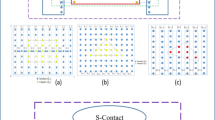Abstract
Nanonetworks consist of nano-sized communicating devices which are able to perform simple tasks at the nanoscale. The limited capabilities of individual nanomachines and the Terahertz (THz) band channel behavior lead to error-prone wireless links. In this paper, a cross-layer analysis of error-control strategies for nanonetworks in the THz band is presented. A mathematical framework is developed and used to analyze the tradeoffs between Bit Error Rate, Packet Error Rate, energy consumption and latency, for five different error-control strategies, namely, Automatic Repeat reQuest (ARQ), Forward Error Correction (FEC), two types of Error Prevention Codes (EPC) and a hybrid EPC. The cross-layer effects between the physical and the link layers as well as the impact of the nanomachine capabilities in both layers are taken into account. At the physical layer, nanomachines are considered to communicate by following a time-spread on-off keying modulation based on the transmission of femtosecond-long pulses. At the link layer, nanomachines are considered to access the channel in an uncoordinated fashion, by leveraging the possibility to interleave pulse-based transmissions from different nodes. Throughout the analysis, accurate path loss, noise and multi-user interference models, validated by means of electromagnetic simulation, are utilized. In addition, the energy consumption and latency introduced by a hardware implementation of each error control technique, as well as, the additional constraints imposed by the use of energy-harvesting mechanisms to power the nanomachines, are taken into account. The results show that, despite their simplicity, EPCs outperform traditional ARQ and FEC schemes, in terms of error correcting capabilities, which results in further energy savings and reduced latency.





Similar content being viewed by others
References
Abadal, S., Alarcon, E., Cabellos-Aparicio, A., Lemme, M., & Nemirovsky, M. (2013). Graphene-enabled wireless communication for massive multicore architectures. IEEE Communications Magazine, 51(11), 137–143.
Akyildiz, I. F., & Jornet, J. M. (2010). Electromagnetic wireless nanosensor networks. Nano Communication Networks (Elsevier) Journal, 1(1), 3–19.
Bai, P., Zhu, G., Liu, Y., Chen, J., Jing, Q., Yang, W., et al. (2013). Cylindrical rotating triboelectric nanogenerator. ACS Nano, 7(7), 6361–6366.
Cabellos-Aparicio, A., Llatser, I., Alarcon, E., Hsu, A., & Palacios, T. (2015). Use of thz photoconductive sources to characterize tunable graphene rf plasmonic antennas. IEEE Transactions on Nanotechnology, 14(2), 390–396.
Chi, K., Zhu, Y. H., Jiang, X., & Leung, V. (2014). Energy-efficient prefix-free codes for wireless nano-sensor networks using ook modulation. IEEE Transactions on Wireless Communications, 13(5), 2670–2682.
Chi, K., Zhu, Y. H., Jiang, X., & Tian, X. (2013). Optimal coding for transmission energy minimization in wireless nanosensor networks. Nano Communication Networks (Elsevier) Journal, 4(3), 120–130.
COMSOL Multiphysics Simulation Software: COMSOL. http://www.comsol.com/products/multiphysics/.
Domingo, M. C., & Vuran, M. C. (2012). Cross-layer analysis of error control in underwater wireless sensor networks. Computer Communications (Elsevier) Journal, 35(17), 2162–2172.
Jornet, J. M. (2014). Low-weight error-prevention codes for electromagnetic nanonetworks in the terahertz band. Nano Communication Networks (Elsevier) Journal, 5(1–2), 35–44.
Jornet, J. M., & Akyildiz, I. F. (2011). Channel modeling and capacity analysis of electromagnetic wireless nanonetworks in the terahertz band. IEEE Transactions on Wireless Communications, 10(10), 3211–3221.
Jornet, J. M., & Akyildiz, I. F. (2012). Joint energy harvesting and communication analysis for perpetual wireless nanosensor networks in the terahertz band. IEEE Transactions on Nanotechnology, 11(3), 570–580.
Jornet, J. M., & Akyildiz, I. F. (2013). Graphene-based plasmonic nano-antenna for terahertz band communication in nanonetworks. IEEE JSAC, Special Issue on Emerging Technologies for Communications, 12(12), 685–694.
Jornet, J. M., & Akyildiz, I. F. (2014). Femtosecond-long pulse-based modulation for terahertz band communication in nanonetworks. IEEE Transactions on Communications, 62(5), 1742–1754.
Jornet, J. M., Pujol, J. C., & Pareta, J. S. (2012). Phlame: A physical layer aware mac protocol for electromagnetic nanonetworks in the terahertz band. Nano Communication Networks (Elsevier) Journal, 3(1), 74–81.
Kocaoglu, M., & Akan, O. B. (2013). Minimum energy channel codes for nanoscale wireless communications. IEEE Transactions on Wireless Communications, 12(4), 1492–1500.
Lin, S., & Costello, D. J. (2004). Error control coding: Fundamentals and applications (Vol. 114). Englewood Cliffs: Pearson-Prentice Hall.
Priebe, S., & Kurner, T. (2013). Stochastic modeling of thz indoor radio channels. IEEE Transactions on Wireless Communications, 12(9), 4445–4455.
Tabor, J. (1990). Noise reduction using low weight and constant weight coding techniques. Tech. rep., MIT, Cambridge, MA.
Vuran, M. C., & Akyildiz, I. F. (2009). Error control in wireless sensor networks: A cross layer analysis. IEEE/ACM Transactions on Networking, 17(4), 1186–1199.
Wang, P., Jornet, J. M., Abbas Malik, M., Akkari, N., & Akyildiz, I. F. (2013). Energy and spectrum-aware mac protocol for perpetual wireless nanosensor networks in the terahertz band. Ad Hoc Networks (Elsevier) Journal, 11(8), 2541–2555.
Wang, Z. L. (2008). Towards self-powered nanosystems: From nanogenerators to nanopiezotronics. Advanced Functional Materials, 18(22), 3553–3567.
Author information
Authors and Affiliations
Corresponding author
Additional information
This project was funded by the National Plan for Science, Technology and Innovation (MAARIFAH)-King Abdulaziz City for Science and Technology- the Kingdom of Saudi Arabia- award number 12-NAN230-03. The authors also acknowledge with thanks the Science and Technology Unit, King Abdulaziz University for technical support.
Rights and permissions
About this article
Cite this article
Akkari, N., Jornet, J.M., Wang, P. et al. Joint physical and link layer error control analysis for nanonetworks in the Terahertz band. Wireless Netw 22, 1221–1233 (2016). https://doi.org/10.1007/s11276-015-1024-y
Published:
Issue Date:
DOI: https://doi.org/10.1007/s11276-015-1024-y




